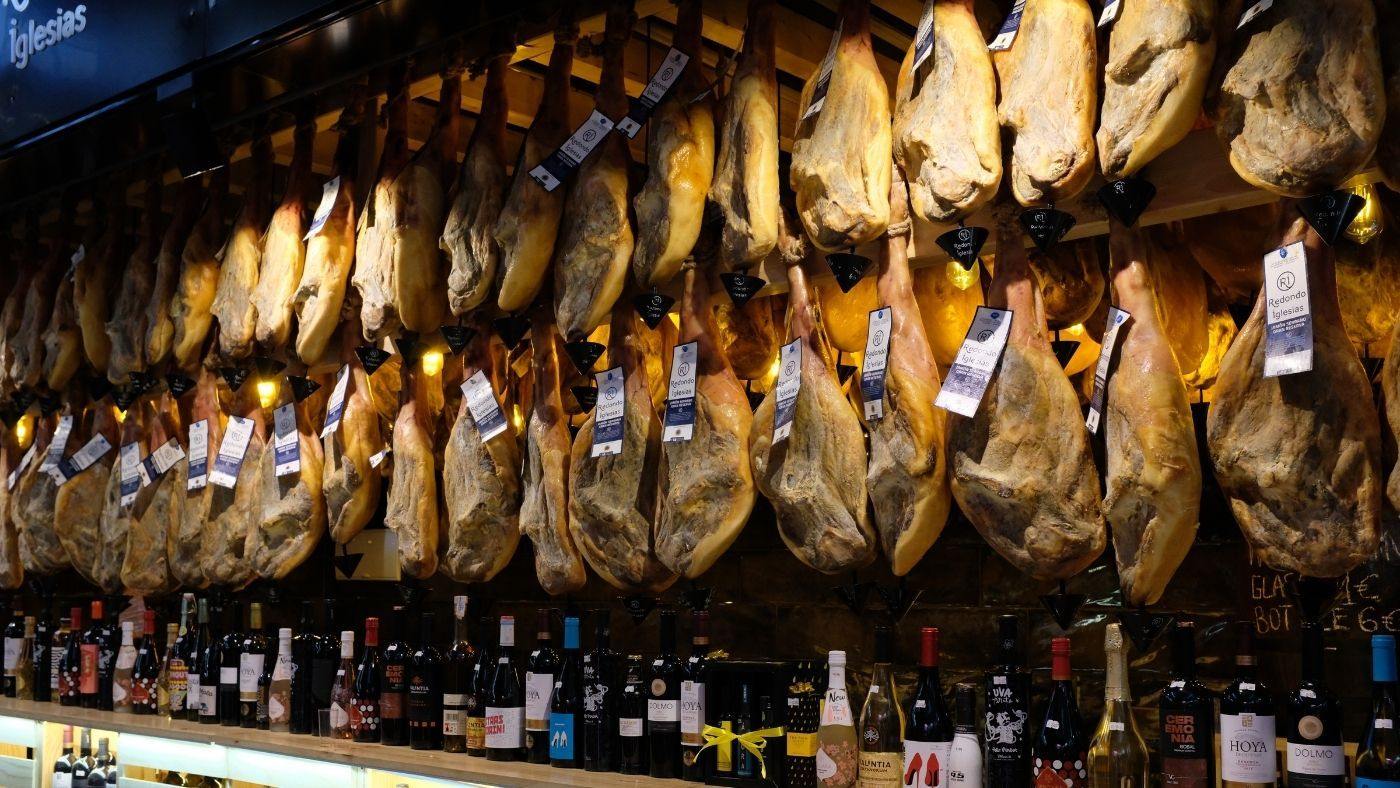If you could only choose one type of food for the rest of your life, what would it be? I know what I would choose: Spanish ham.
In Spain, nothing is as important as ham. It's bigger than religion, bigger than football, and goes beyond mere obsession. This isn't just food, it's life. Do not you believe me? Just ask a local!
But what is so special about Spanish ham? And what should you know before you go to Spain and order your Jamon in a bar or restaurant? How do you know which ham to choose?
If you go to a restaurant in Spain, you will often find three or four types of Spanish ham on the menu, with prices ranging from five euros per kilo to more than 100 euros per kilo! So what's the difference, and is that big difference worth it?
The best ham in the world
There is little food that is more Spanish than (Spanish ;)) ham. Alongside gazpacho and paella, it is perhaps the country's most iconic food.
Spanish ham (jamón) is the one food that all Spaniards should like. Whenever someone says they don't like jamon, the average Spaniard's response is, "Well, you never tried the good stuff!".
For a Spaniard it is impossible. It can't be that someone doesn't like Jamon.
Do you still need to be convinced? Then we would like to introduce you to 'the good stuff' - Jamon Iberico . A wonderful ham that melts on your tongue. Jamon Iberico is in great demand worldwide and, like champagne, has the exclusive requirement that it comes from the right area. The most expensive ham in the world is also one of these Spanish beauties, costing a whopping €4,000.

But before you get to this ridiculously delicious (and very expensive) level of Spanish ham, there's a plethora of types, varieties, production methods and colors to choose from.
What is Spanish Ham?
Spanish ham is the best thing that can happen to a pig's hind leg. Instead of cooking the ham, make jamón by letting the leg dry dry. After slaughter, the legs are trimmed and cleaned, then stacked in a barrel full of salt. They are left for about two weeks to drain as much moisture as possible.
Then the salt is wiped off and the legs are hung and cured. It is then sliced wafer-thin and served as an aperitif alongside other meats, sausages and cheeses.
The Spanish ham-making tradition dates back more than 2,000 years, when the Roman Empire controlled most of Spain. Spanish ham was a delicacy even to the exotic taste buds of the Romans. Pliny the Elder even praised jamón for its complexity, arguing that "the flesh of these pigs has nearly fifty flavours!".
In the hundreds of years that followed, Jamon was a specialty reserved only for royalty and clergy. It was not until the 13th century that ham found its way to the table of all people. Today, the average Spaniard eats more than 3.5 kilos of jamon per year!
But under that broad umbrella of jamón there is a huge variation in price and quality. The most important variable in categorizing Spanish ham is the breed of the pig. Because when it comes to Spanish ham, not all pigs are born equal.
Serrano Ham
Jamón serrano is the name of the most common Spanish ham. In fact, some 93% of all ham comes from Spain Jamon Serrano! You will find it in supermarkets, on the menus of bars and restaurants and you can eat it as a snack on a sandwich, for example. It is simple and delicious, but it is the least special ham. If this is the only ham you eat while in Spain, you've done yourself a disservice!
But while it can be considered the lower, run-of-the-mill Spanish ham, the quality (and price) can vary quite a bit.
So what exactly is jamón serrano and why is it different from Iberico ham?
White pigs (Cerdos Blancos)
Serrano ham comes from pigs with the oh so inventive name "white pigs".
When you think of a pig yourself, you probably think of a white pig, or a cerdo blanco. These pink animals are common in the Netherlands and around the world and the breed is usually Landrace, Large White, Duroc or Pietrain. They are bred specifically for industry, suitable for mass production of pork.
You may be thinking, if the pig is pink, why is it called a "white pig"? Besides being much paler than their Iberian cousins, the reason for this is in the hoof. These pigs have white or light brown hooves. Next time you're in a Spanish bar, look for it! The leg including ham is always present, so you can properly assess which variety it is. A nice fact for the next time you are in Spain with family, friends or your partner.
Different types of Serrano Ham
Although Serrano ham is a more industrial ham, and therefore not that special, it still consists of different quality levels.
Since 1990, the Consorcio Serrano (the official regulators for Serrano ham) has been helping to enforce standards for Serrano ham. Nowadays you can find hams with and without an official production guarantee. While producers are not required to be approved by the regulator, there are some important differences to keep in mind.
Jamón Consorcio-Serrano (controlled by the regulatory consorcio):
- Farms inspected and checked for quality.
- Pigs must come from Spain and farms must be located in Spain.
- Minimum curing time of 12 months.
Jamón Serrano (controlled by the regulatory consorcio)
- Farms not checked.
- Pigs can be sourced from anywhere in the world and farms must be located in the EU.
- Minimum curing time of 7 months.
And even within these two classifications, there are three more subtypes of serrano ham. Just as important as the consorcio, these labels are based on how long the ham has been aged. Keep in mind that the pig has only lived in an industrial environment for eight months and has been fed a diet based on grains and grains.
The Bodega – aged between 10 and 12 months
Reserva – aged between 12 and 15 months
Gran Reserva – aged for more than 15 months.
Iberico Ham / Iberian Ham / Jamon Iberico
This is the outdoor category!
Although it may only make up 7% of Spanish ham production, Iberian ham is the best type of Spanish ham. This is the stuff that the Spaniards have a soft spot for and makes grown men howl with joy! While there are reasonably priced hams for around $100, you'll also see hams selling for over $1,000.
So what makes this Spanish ham so special? That all depends on the pig.
Iberian pigs (Cerdos Ibéricos)
If these foot-long, fat-covered pig's feet look medieval, that's because they are.

These pigs are native to the south of Spain and Portugal, where they have been roaming for thousands of years. Phoenician traders brought the first pigs to the Iberian Peninsula, where they mated with local wild boars to produce the iconic Iberian pig.
You can distinguish these pigs from cerdos blancos by their jet black skin and coat, their long ears, snout and iconic hooves. These pigs are also unique in their lifestyle. For the best ham, Iberian pigs are a crucial part of their local ecosystem.
A pig fed with acorns (Bellota).
To make the top quality ham, some pigs are treated like kings. Once they weigh 100 kilograms, the piggies roam freely across the farm's forest-filled meadows (called a dehesa), filled with olive groves, acorn trees, chestnut trees and wild herbs. The pigs help to fertilize the area and the trees in turn provide food for the pigs.
Aside from the wild herbs and grasses of these pastures, acorns are the main food for the pigs. During the fall and winter, the pigs are released to roam freely and eat acorns, each eating up to 10 pounds a day! As a result, each pig gains approximately one weight per day.
The sweet, nutty flavor of the acorns penetrates deep into the meat, giving it a subtle and unique flavor. The pigs also absorb oleic acid from the nuts, changing the biology of their body fat. Due to the health benefits of vegetable fats, this ham has even been proven to lower cholesterol in your body!
But unfortunately not every Iberian ham is produced in this way. So how can you tell the jerk-fed ham apart from the rest?
Different types of Iberico Ham
Fortunately, the quality of Iberian ham is strictly controlled by the Spanish government.
Jamón ibérico is divided into different quality categories based on the diet of the pigs and the percentage of Iberian genes present in each pig. Each pot is given a colored label by which the quality can be recognized. There are four colors; black, red, green and white (in descending order of quality).
Jamon iberico de bellota
- The best hams in Spain (Read: the best hams in the world)
- These pigs forage for acorns (bellotas) in open fields every winter and fall.
- Look for a black label on these hams, which means it's a full-blooded Iberian pig. Only about 5 percent of Spanish ham carries a black label.
- Red labels also mean that the pigs are free to roam the acorn orchards, but are not 100% genetically Iberian. They must be above 50% Iberian pig, the rest a cross with a Duroc pig. These legs must be cured for a minimum of three years to a maximum of five years.
- Jamon iberico de bellota is also called Pata Negra (black leg).
Jamón ibérico de cebo de campo
- These are what you might call "free range" pigs, which are at least 50% Iberico. They forage for their food in open fields eating wild plants and some acorns. But they don't get enough acorns to make up a complete diet, so the farmer supplements them with grain-based feed.
- These hams are marked with a green label and must be aged for at least three years.
Jamon iberico de cebo
- These pigs are raised on grains (cebo) and eat little or no acorns. Think of these as your conventionally raised pigs, which are at least 50% Iberico.
- This is about 2/3 of the total production of Iberico ham and is aged for at least two years. You can recognize it by the white label.
Where does the Iberico ham come from?
Although you can make serrano ham anywhere in Spain, jamón ibérico is much stricter!
Like Spanish wine and olive oil, Iberian ham is protected by the EU regime of protected designations of origin. These designations determine where and how to make a country's traditional dishes, to protect its heritage and standardize its quality.
Since the taste of the land and the dehesa are so important for the production of Iberico ham, the EU recognizes four different titles / areas for the production of jamón ibéric. These are:
- DOP Jabugo : In Andalusia, near Seville and Huelva.
- DOP Extremadura : This title protects ham produced in western Spain, around Badajoz and Caceres.
- DOP Los Pedroches : Also in the south of Spain, near Cordoba in Andalusia.
- DOP Guijuelo : This title accounts for almost two-thirds of all jamón ibérico de bellota. It is also the largest covered area in Extremadura, Castilla y Leon, Castilla La Mancha and parts of Andalusia. This is where the Jamon Iberico from Iberico Fino comes from.


